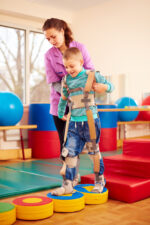Walking Ability Found to Worsen With Age in Adults With Dravet

Adults with Dravet syndrome commonly experience walking difficulties that tend to worsen with age, a small study reports.
“In this study, it was observed that gait parameters and parkinsonian symptoms were abnormal across all ages, but clearly worse in older patients, suggesting a progressive gait disorder,” researchers wrote.
By the end of the five-year study period, one-third of the patients who were ambulatory at its start were no longer able to walk, the team noted.
The study, “Progressive Worsening of Gait and Motor Abnormalities in Older Adults With Dravet Syndrome,” was published in Neurology.
Most formal studies on Dravet syndrome have focused on children with the condition; there is relatively little published research on how the seizure disorder tends to manifest in adults.
Now, a team of scientists in the U.S. and Canada conducted a small study to assess how walking ability changes in adults with Dravet over time. The scientists were inspired to do the research by anecdotal reports from caregivers that described adults with Dravet syndrome who had been able to walk but then lost that ability.
A total of six adults with Dravet, with a mean age of 32, were involved in the study. They were assessed five years apart, once in 2014 and then again in 2019. A modified version of the Unified Parkinson’s Disease Rating Scale (mUPDRS) was used to measure gait abnormalities, as well as resting tremors, facial expression, standing up from a seated position, posture, and body bradykinesia, which is an abnormal slowness of movement.
Results showed that, over the five years between assessments, mUPDRS scores worsened for all but one of the six patients.
“We found evidence of a decline in gait function and increase in parkinsonian manifestations,” the researchers wrote.
Notably, the lone exception — a 24-year-old woman — had started on a new medication between the two assessments. That medication, levodopa, is used to improve muscle control.
Two of the oldest participants — ages 47 and 51 at the second assessment in 2019 — were able to walk at the first assessment, but could no longer do so at the follow-up.
“Their caregivers reported that in this period of 5 years, it became increasingly difficult to have them leave their wheelchair and even with support, their gait was too ‘unsafe,'” the researchers wrote.
The team noted that these two patients also received levodopa after their first evaluation, but the medication was discontinued after they stopped walking.
A further analysis, which included mUPDRS scores recorded at a single point in time from 12 Dravet syndrome patients, showed a statistically significant association between mUPDRS scores and age, wherein older individuals tended to have worse scores. Older age was also specifically associated with worse scores for gait, body bradykinesia, and rising from a seat.
Instrumental gait analysis — a procedure where worn sensors are used to assess walking dynamics — also showed generally worse walking characteristics among older individuals with Dravet syndrome.
The researchers stressed that this study is limited by its small size, and also noted that clinical factors like medications and diagnostic delays likely play a role in determining walking ability over the long term.
However, they noted that “even this limited sample provides novel information,” with evidence of patients in fact losing their ability to walk over the five-year span.
“Taken altogether, the results show a progressive deterioration of gait and motor function as [Dravet syndrome] patients age,” the scientists concluded, saying additional research is needed among a larger patient population.
“It is yet unclear why such deterioration happens with age and further research should help explain not only why this happens, but also if it is possible to slow down or even avoid this progression,” they wrote.








